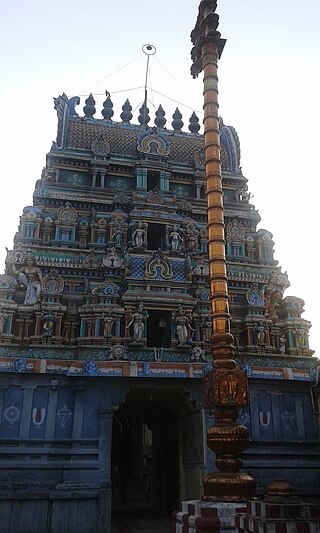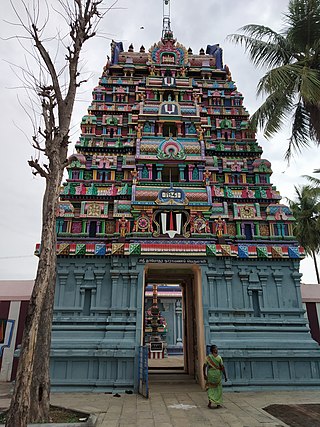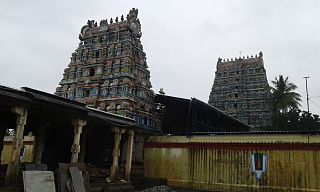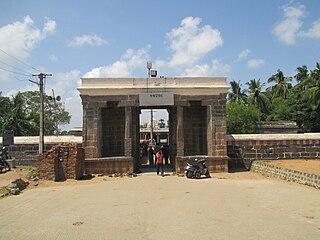
Namakkal is a city and the headquarters of Namakkal district, Tamil Nadu. It is the first ISO 14001-2004 certified municipality in Asia for environmental management, specifically the provision and maintenance of water supply, solid waste and sewage management, town planning, lighting and other social services. Namakkal is known as the Egg City due to its large egg production and Transport city.

Koodal Aḻagar Temple in Madurai, a city in the South Indian state of Tamil Nadu, is dedicated to the Hindu god Vishnu. Constructed in the Dravidian style of architecture, the temple is glorified in the Naalayira Divya Prabandham, the early medieval Tamil canon of the Alvar saints from the 6th–9th centuries CE. It is one of the 108 Divya Desams dedicated to Vishnu, who is worshipped as Viyooga Sundarrajan, and his consort Lakshmi as Mathuravalli.

The Devaadi Raja Perumal temple in Therazhundur, a village in Mayiladuthurai district of the South Indian state of Tamil Nadu, is dedicated to the Hindu god Vishnu. Constructed in the Dravidian style of architecture, the temple is glorified in the Naalayira Divya Prabandham, the early medieval Tamil canon of the Alvar saints from the 6th–9th centuries CE. It is one of the 108 Divya Desams dedicated to Vishnu, who is worshipped as Amaruviappan, and his consort Lakshmi as Sengamalavalli Thayar. The original structure of the temple was built by the Karikala Chola during the 1st century CE, with later additions from the Cholas during the 11th century.

Thiru Anbil, or Sundararaja Perumal Temple, in Anbil, a village in the outskirts of Tiruchirappalli in the South Indian state of Tamil Nadu, is dedicated to the Hindu god Vishnu. Constructed in the Dravidian style of architecture, the temple is glorified in the Naalayira Divya Prabandham, the early medieval Tamil canon of the Alvar saints from the 6th–9th centuries CE. It is one of the 108 Divya Desams dedicated to Vishnu, who is worshipped as Sundararajan and his consort Lakshmi as Sundaravalli.

Nachiyar Kovil or Thirunarayur Nambi Temple is a Hindu temple in Thirunarayur, a village in the outskirts of Kumbakonam in the southern Indian state of Tamil Nadu, is dedicated to the Hindu god Vishnu and her consort lakshmi. Nachiyar koil is one of 2 divyadesams were Lakshmi is pradaana over Vishnu. Thirunaraiyur is the sub urban region of business city of Kumbakonam.

Tirupavalavannam or Pavalavanam temple located in Kanchipuram in the South Indian state of Tamil Nadu, is dedicated to the Hindu god Vishnu. Constructed in the Dravidian style of architecture, the temple is glorified in the Nalayira Divya Prabandham, the early medieval Tamil canon of the Alvar saints from the 6th–9th centuries CE. It is one of the 108 Divya Desams dedicated to Vishnu, who is worshipped as Pavalavannar Perumal and his consort Lakshmi as Pavalavalli.

The Loganatha Perumal Temple is a Hindu temple dedicated to Vishnu located 2 km away from Sikkal, Tamil Nadu, India on the Tiruvarur-Nagapatnam highway. Constructed in the Dravidian style of architecture, the temple is glorified in the Nalayira Divya Prabandham, the early medieval Tamil canon of the Alvar saints from the 6th–9th centuries CE. It is one of the 108 Divya Desams dedicated to Vishnu, who is worshiped as Loganatha Perumal and his consort Lakshmi as Loganayagi.

Srivaikuntanathan Perumal Temple in Srivaikuntam, a town in Thoothukudi district in the South Indian state of Tamil Nadu, is dedicated to the Hindu god Vishnu. It is located 22 km from Tirunelveli. Constructed in the Tamil style of architecture, the temple is glorified in the Nalayira Divya Prabandham, the early medieval Tamil canon of the Alvar saints from the 6th–9th centuries CE. It is one of the 108 Divya Desams dedicated to Vishnu, who is worshipped as Vaikunthanathar and his consort Lakshmi as Vaikunthavalli. The temple is also classified as a Nava Tirupati, the nine temples revered by Nammalvar located in the banks of Tamiraparani river. The temple is next only to Alwarthirunagari Temple in terms of importance among the nine Navatirupathi temple. The temple is one of the Navagraha temples in Vaishnavism, associated with Surya, the sun god.

Kalugasalamoorthy Temple in Kalugumalai, a panchayat town in Thoothukudi district in the South Indian state of Tamil Nadu, is dedicated to the Hindu god Murugan. Constructed in the Dravidian style of architecture, the temple is believed to have been expanded during the 18th century with the images excavated from Kalugumalai. The core temple has a rock-cut architecture exemplary of early Pandyan Art. The other portions of Kalugumalai houses the 8th century Kalugumalai Jain Beds and Vettuvan Koil, an unfinished Shiva temple.

Adi Kesava Temple is dedicated to Hindu god Vishnu located in Sriperumbudur, Kanchipuram district, in the South Indian state of Tamil Nadu. Constructed in the Dravidian style of architecture, Vishnu, who is worshipped as Adi Kesava, and his consort Lakshmi as Ethiraja Nadhavalli. The temple is believed to be the birthplace of Ramanuja, the exponent of Vishishtadvaita philosophy. The gold plated shrine in front of the hall of Ramanuja was built by the Maharaja of Mysore. It is considered one among the 108 Abhimana Kshethram of Vaishnavate tradition.

Jagannatha Perumal Temple (also called TirumazhisaiTemple is dedicated to Hindu god Vishnu located in Tirumazhisai, Chennai City, Tiruvallur district, in the South Indian state of Tamil Nadu. Constructed in the Dravidian style of architecture, dedicated to Vishnu, who is worshipped as Jagannatha Perumal and his consort Lakshmi as Thirumangaivalli. The temple is believed to be the birthplace of Thirumazhisai Alvar, one of the twelve Alvars whose work is compiled as Divya Prabandha, the early medieval Tamil canon of the Alvar saints from the 6th–9th centuries CE. The temple is Classified one among the 108 Abhimana Kshethram of Vaishnavate tradition.

Vedarajan Temple in Thirunagari, a village in Mayiladuthurai district in the South Indian state of Tamil Nadu, is dedicated to the Hindu god Vishnu. Constructed in the Dravidian style of architecture, the temple is glorified in the Naalayira Divya Prabandham, the early medieval Tamil canon of the Alvar saints from the 6th–9th centuries CE. It is one of the 108 Divya Desams dedicated to Vishnu, who is worshipped as Vedarajan and his consort Lakshmi as Amruthavalli. The temple is believed to be the birthplace of Thirumangai Alvar, one of the twelve Alvar saints.

The Alagiyasingar Temple in Thiruvali, a village in Mayiladuthurai district in the South Indian state of Tamil Nadu, is dedicated to the Hindu god Vishnu. Constructed in the Dravidian style of architecture, the temple is glorified in the Nalayira Divya Prabandham, the early medieval Tamil canon of the Alvar saints from the 6th–9th centuries CE. It is one of the 108 Divya Desams dedicated to Vishnu, who is worshipped as Alagiyasingar and his consort Lakshmi as Purnavalli.

Kolanjiappar temple in Manavalanallur, a village on the outskirts of Virudhachalam in Cuddalore district in the South Indian state of Tamil Nadu, is dedicated to the Hindu god Murugan. Constructed in the Dravidian architecture, the temple is located in the Virudhachalam - Manavalanallur Road. The legend of the temple is associated with Saivite saint Sundarar and the Vriddhagiriswarar temple ad Virudhachalam.

Balasubramaniyaswamy temple in Vennaimalai, a village in the outskirts of Karur in Karur district in the South Indian state of Tamil Nadu, is dedicated to the Hindu god Murugan. Constructed in the Dravidian style of architecture, the temple is located in the Karur - Pugalur Road. The legend of the temple is associated with Kamadhenu taking up the duties of Hindu god of creation Brahma and creating the hill of butter named Vennaimalai.

The Narasimhaswamy temple in Namakkal, a town in Namakkal district in the South Indian state of Tamil Nadu, is dedicated to the Hindu god Narasimha, an avatar of Vishnu. The temple is one of the 108 Abhimana Kshethrams of Vaishnavate tradition. Constructed in the Dravidian style of architecture and Rock-cut architecture, the temple is located in the Salem–Namakkal–Trichy Road. The legend of the temple is associated with Narasimha, an avatar of Hindu god Vishnu appearing for Lakshmi, his consort, and Hanuman. Based on the architectural features, historians believe that the temple was built during the 6th century by the Adiyamans also called Satyaputras as evident from the inscription mentioning the temple as 'Adiyendra Vishnu Gruham' or 'The house of Vishnu of the Adiyaman kings'.

Kanthaswamy Temple in Cheyyur, in Chengalpattu district in the South Indian state of Tamil Nadu, is dedicated to the Hindu god Murugan. Constructed in the Dravidian style of architecture, the temple was constructed during the Cholas during the 10th century. Murugan is worshipped as Kanthaswamy along with his consorts Valli and Deivasena. A granite wall surrounds the temple, enclosing all its shrines.

Kunnakudi Shanmughanathar temple in Kundrakudi, a village in the outskirts of Karaikudi in Sivaganga district in the South Indian state of Tamil Nadu, is dedicated to the Hindu god Murugan. Constructed in the Hindu style of architecture, the temple is located in the Tirupattur - Karaikudi Road, around 14 km (14,000 m) from Karaikudi. There are three caves located on the western side of the lower rock, that has rock-cut shrines from the Pandyan Empire from the 8th century. The caves have the earliest sculptural representation of Dvarapalas, the guardian deities, for any South Indian temple.

Abaya Hastha Swayambu Sri Lakshmi Narasimha Swamy Temple is a holy Hindu religious site in the village of Agaram Agraharam in Hosur taluk of Krishnagiri district in the Indian state of Tamil Nadu. It is located 15 km from Hosur on Rayakotta Road and 65 km from Bangalore.

Nithyakalayana Perumal temple in Thiruvidandai, a village in Chennai, Chengalpattu district of the South Indian state of Tamil Nadu, is dedicated to Varaha, the boar avatar of the Hindu god Vishnu. Constructed in the Tamil style of architecture, the temple is glorified in the Naalayira Divya Prabandham, the early medieval Tamil canon of the Alvar saints from the 6th–9th centuries CE. It is one of the 108 Divya Desams dedicated to Vishnu, who is worshipped as Nithyakalayana Perumal (Varaha) and his consort Lakshmi as Komalavalli Thayar. The original structure of the temple was built by the Pallavas during the 7th century CE, with later additions from the Cholas during the 11th century.






















